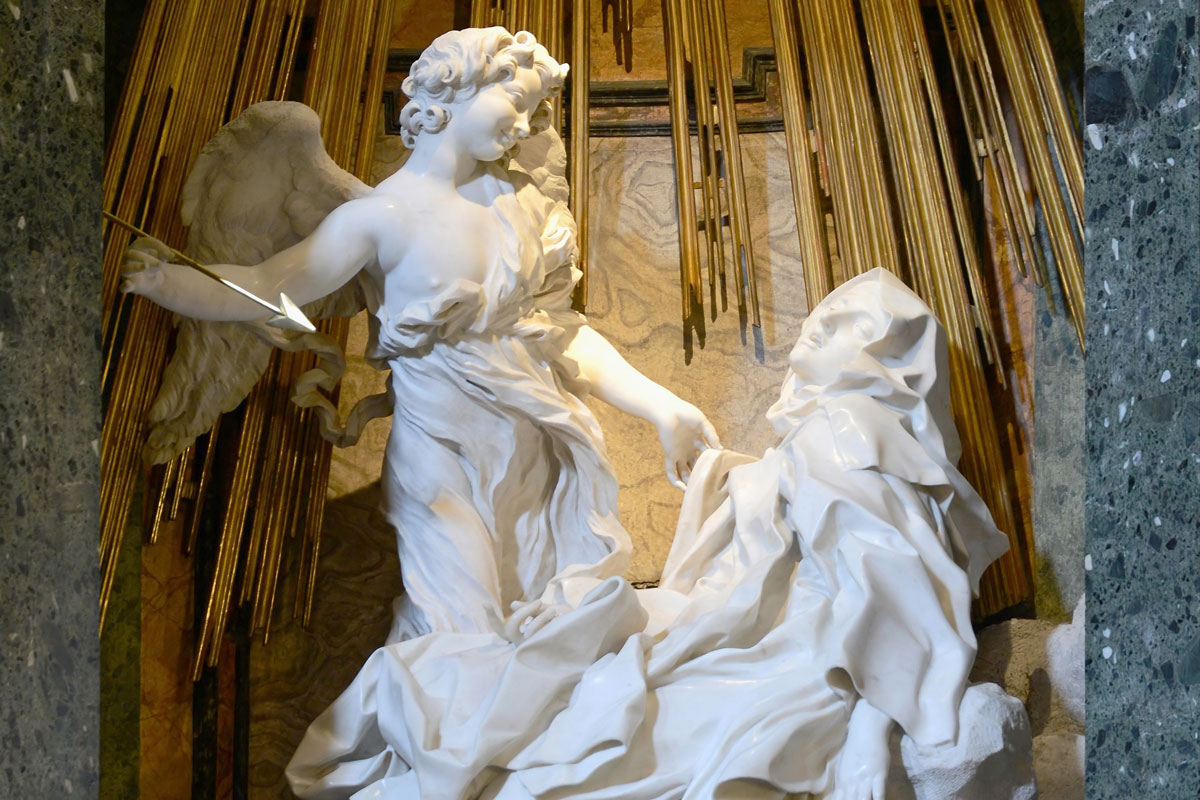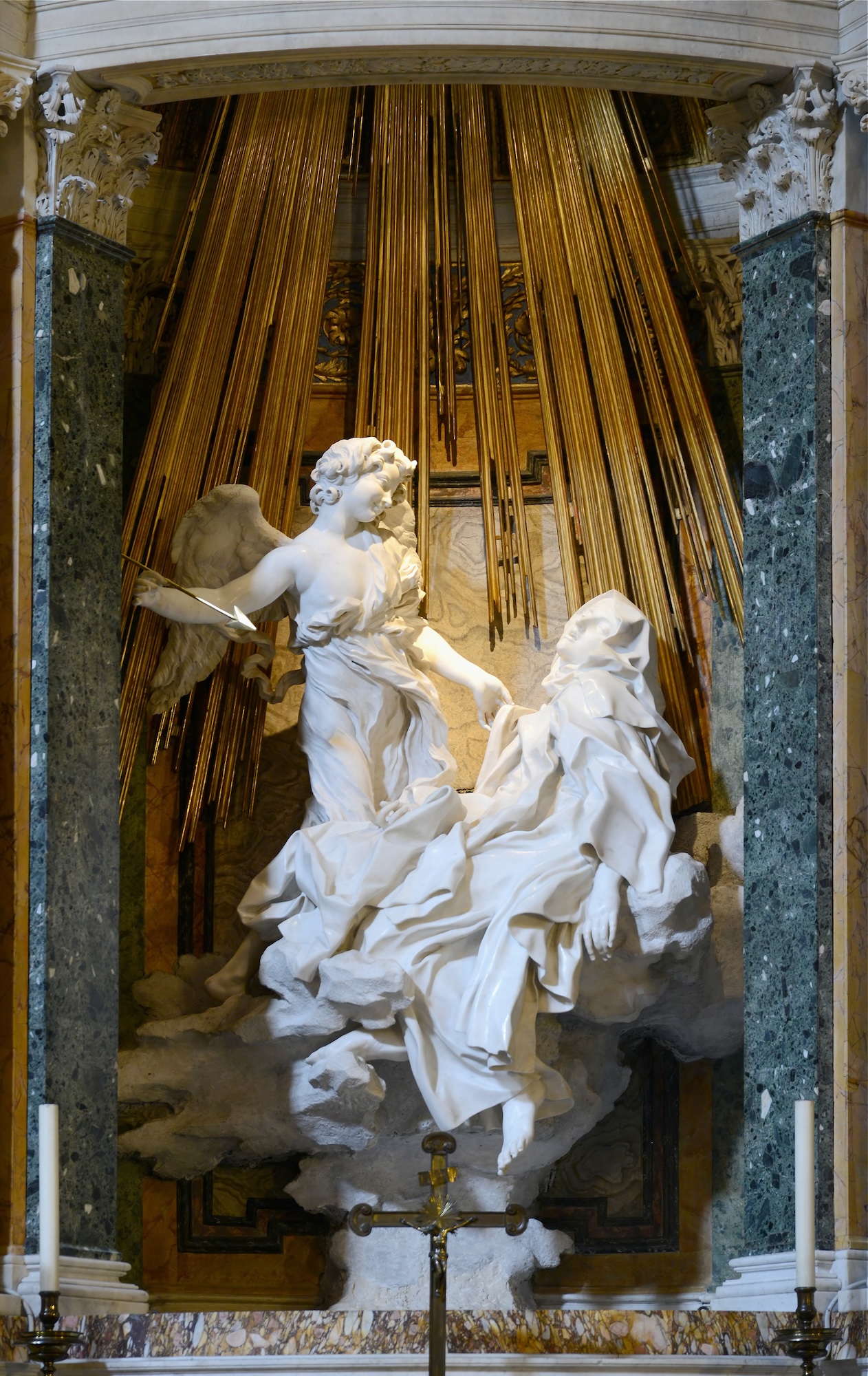The Advent Project: Week 5預覽

Dec. 29: Oh Draw Me Lord: Longing for Christ


Ecstasy of Saint Teresa, Gian Lorenzo Bernini c. 1647–1652. Sculptural installation, Cornaro Chapel, Santa Maria della Vittoria, Rome, Italy. Public domain.
“O Draw Me Lord” from the album Press On. Performed by Selah. Composed byDavid Baroni.
“My Jesus I Love Thee” from the album You Deliver Me. Performed by Selah. Lyrics: William Ralph Featherston, Music: Adoniram Judson Gordon.
Week Five Introduction
Christ and His Bride: The Many Faces of Love
In Matthew 22:30, Christ clarified that the human state of marriage as we know it does not exist in heaven. “For in the resurrection they neither marry nor are given in marriage, but are like angels of God.” The eternal union described in the Bible is the mystical marriage between Christ, the bridegroom, and the universal church, Christ’s bride. It seems clear that God purposefully created earthly marriage, with its inherent characteristics of love, to function as a powerful visual metaphor that enhances our understanding of the divine-human relationship. It’s as though the connection between earthly marriage and union with God in Christ was hardwired. John Stemberger writes, “Other than the Cross, there is no symbol in all of Scripture that is more central to the heart of God, and more central to His purposes than God’s design for marriage. Marriage not only tells us something about who God is, but it gives us a picture of the Gospel and ultimately explains the culmination of all things.”
The Word of God is filled with accounts of both positive and negative marriage scenarios. The union of Mary and Joseph is the supreme example of holy wedlock. Both partners humbly conformed their hearts to God’s will with openness and trust. In the Song of Songs, a very different sort of relationship is depicted. Astonishingly, the dominant voice is that of the Shulamite who periodically acts as the initiator, celebrating a spirit of affectionate reciprocity with her lover. Even more surprising is the book’s striking emphasis on eroticism. Dr. Timothy Patitsas suggests that within the church, eros is an essential word that conveys much more than sexual desire: “By ‘erotic’ we mean the love that makes us forget ourselves entirely and run towards the other without any regard for ourselves.” The Song’s allegorical message calls believers to a radical self-abandonment that exclusively focuses on worshiping Christ in thanksgiving and praise.
This movement toward doxology was emphasized in the marriage vows of the oldBook of Common Prayer, which read, “With this ring I thee wed, and with my body, I thee worship.” Like marriage, the Christian life is to be fully embodied and lived with the whole of our beings. Our relationship with Christ is not just rational or merely emotional but goes to the very core of what it means to be human. Called to offer ourselves to him—body, soul, and spirit—we become one with him, in an ongoing exchange of love which will be magnified and perfected in the age to come. Every Christian is called into this profound and mysterious sacred union. “That Christ may dwell in your hearts through faith; that you, being rooted and grounded in love, may be able to comprehend with all the saints what is the width and length and depth and height—to know the love of Christ which passes knowledge; that you may be filled with all the fullness of God” (Ephesians 3:17–19).
Poetry:
“Loving Colloquy”
by Teresa of Ávila
If all the love you have for me,
my God, is like my love for you,
say, what detains me, that I do?
Or what is it delaying thee?
— Soul, what of me are your desires?
— My God, no more than you to see.
— And what most in you fear inspires?
— What I fear most is losing thee,
A soul within its God now hidden,
whatever else should it desire,
but to e’er greater love aspire,
and in that love remain all hidden,
returned anew into love’s fire?
One love that owns me I request,
my God, my soul within you centered,
for making me the sweetest nest
where union can the best be entered.
OH DRAW ME LORD: LONGING FOR CHRIST
“Draw me away!” calls the lovesick Shulamite to her beloved. “Draw me away, and we will run after you.” The simple, repetitive prayer, Oh Draw Me Lord, is a passionate plea of the heart to flee to that secret place with the Master—the One who IS love. The Lord promises in John 12:32 and Jeremiah 31:3 that as He is lifted up, He will “draw all [peoples] to Himself with an everlasting love.” No one is excluded from our Savior’s magnetizing attraction. God moves among us in mysterious ways, imploring and calling those from every “tongue and tribe and nation” (Revelation 7:9).
As He has sought and healed the hungry for centuries in His time and myriad ways, there are fascinating current reports of Jesus appearing in dreams and visions to desperate seekers living in dangerous and difficult places where Christians are persecuted because of their unwavering love for Christ. Rev. Tom Doyle writes, “We believe more Muslims have become followers of Jesus in the last twenty-five years than in the last fourteen centuries.” The same thing is happening among China’s underground Christians where revelations of Christ also occur. The Holy Spirit is moving in unexpected ways in our generation. Isik Abia, a Turkish Muslim woman, tells her story:
On the day I was going to commit suicide I met Jesus Christ in a supernatural, miraculous encounter that changed my life completely. I didn’t know any doctrine or theology, but I knew that Christ was real and that He was in the room with me as I surrendered my life to Him. This suicidal, abused, hateful Muslim woman was gone. I was filled with the love of God, the joy of God. I wanted to run out into the street and kiss and hug everybody.
Ecstasy (rapturous delight), as evidenced by Isik Abia on the day of her conversion is characteristic of those smitten with the transformational love of Christ. The Incarnation is a primary example of God’s demonstrated ecstasy for the human race. Our heartfelt response should be to run after Him.
I have always been intrigued with Gian Lorenzo Bernini’s 1652 installation,The Ecstasy of St. Teresa, one of the greatest sculptures in the canon of Western Art. In Bernini’s hands the entire space of the Cornaro Chapel, Santa Maria della Vittoria in Rome, becomes a theatrical stage on which an intimate spiritual scenario takes place. Teresa of Avila, a Carmelite nun who lived in 16th century Spain, was a visionary prayer warrior, whose personal encounters with Christ were profound. Bernini’s daring depiction of a contemplative Teresa levitating in a divine moment of rapture is disquieting. Teresa writes in her autobiography of this experience—her “mystical marriage to Christ":
“On my left, an angel appeared in human form...In his hands I saw a golden spear and at the end of the iron tip I seemed to see a point of fire. With this he seemed to pierce my heart several times so that it penetrated to my entrails. When he drew it out, I thought he was drawing them out with it, and he left me utterly consumed by the great love of God…so excessive was the sweetness caused me by this intense pain that one can never wish it to cease, nor will one's soul be content with anything less than God.”
Lest we find Teresa’s visions troubling, let’s not forget the Apostle Paul who miraculously encountered Christ on the road to Damascus and was himself “caught up into the third heaven” where he witnessed “surpassing great revelations” (2 Corinthians 12:7). Throughout his writings Paul talks reverently about “knowing Christ,” being “united with Christ,” and Christ as ”husband or spouse”—all texts challenging Christians to an ever purer and deeper relationship with God. One of Paul’s best known prayers for the church is found in Ephesians 3: “May Christ dwell in your hearts through faith; that you, being rooted and grounded in love, may be able to comprehend with all the saints what is the width and length and depth and height—to know the love of Christ which passes knowledge; that you may be filled with all the fullness of God.”
The Song of Songs describes the persistent, extravagant love of a Christ who draws us to Himself and in response our overwhelming yearning to be permanently united with Him. The commitment, romance, and intimacy of a sensitive marriage partner is the kind of relationship Christ desires to share with us. He continually longs for our affection. For centuries monastics in the liturgical church have not only taken vows of celibacy, but like Teresa of Avila, have experienced the glories of wedded love, confidently seeing themselves as married to Christ their faithful Bridegroom. May we in turn come to look upon ourselves in a similar way, as forever wed to the greatest “Lover of our souls.” In his book Surprised by Joy, C.S. Lewis writes, “Into the region of awe, in deepest solitude there is a road right out of the self, a commerce with…the naked Other, imageless (though our imagination salutes it with a hundred images) unknown, undefined, desired.”
Prayer:
I am Thine, O Lord, I have heard Thy voice,
And it told Thy love to me;
But I long to rise in the arms of faith,
And be closer drawn to Thee.
Consecrate me now to Thy service, Lord,
By the pow’r of grace divine;
Let my soul look up with a steadfast hope,
And my will be lost in Thine.
O the pure delight of a single hour
That before Thy throne I spend,
When I kneel in prayer, and with Thee, my God,
I commune as friend with friend!
There are depths of love that I yet may know
Ere Thee face to face I see;
There are heights of joy that I yet may reach
Ere I rest in peace with Thee.
Draw me nearer, nearer, nearer blessed Lord,
To the cross where Thou hast died;
Draw me nearer, nearer, nearer, blessed Lord,
To Thy precious, bleeding side.
— Fanny Jane Crosby (1820-1915)
Barry Krammes
Professor Emeritus, Art Department
Biola University
For more information about the artwork, music, and poetry selected for this day, please visit our website via the link in our bio.
關於此計劃

Biola University's Center for Christianity, Culture & the Arts is pleased to share the annual Advent Project, a daily devotional series celebrating the beauty and meaning of the Advent season through art, music, poetry, prayer, Scripture, and written devotions. The project starts on the first day of Advent and continues through Epiphany. Our goal is to help individuals quiet their hearts and enter into a daily routine of worship and reflection during this meaningful but often hectic season. Our prayer is that the project will help ground you in the unsurpassable beauty, mystery and miracle of the Word made flesh.
More









